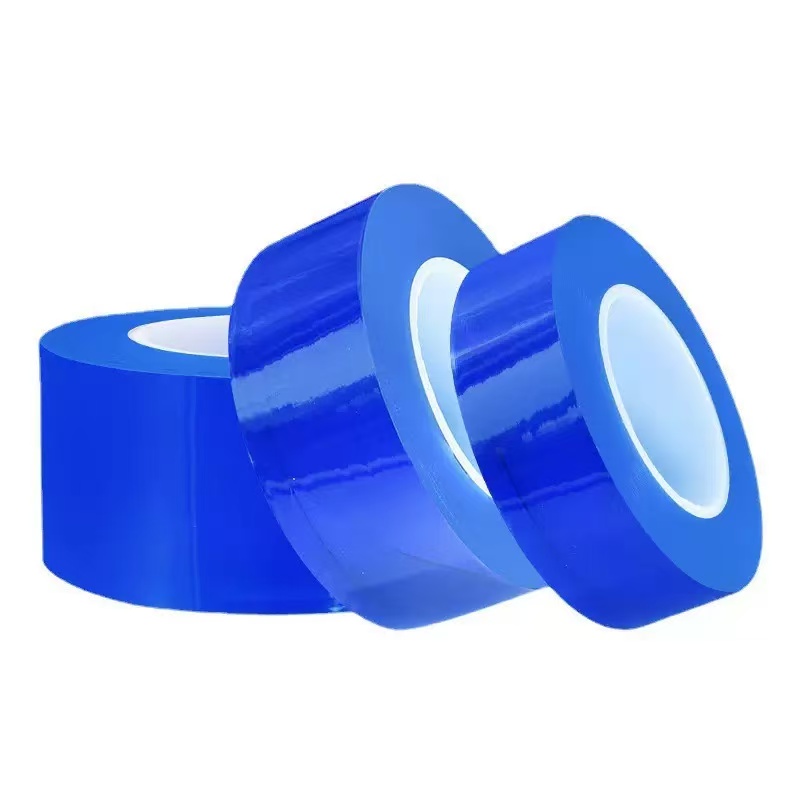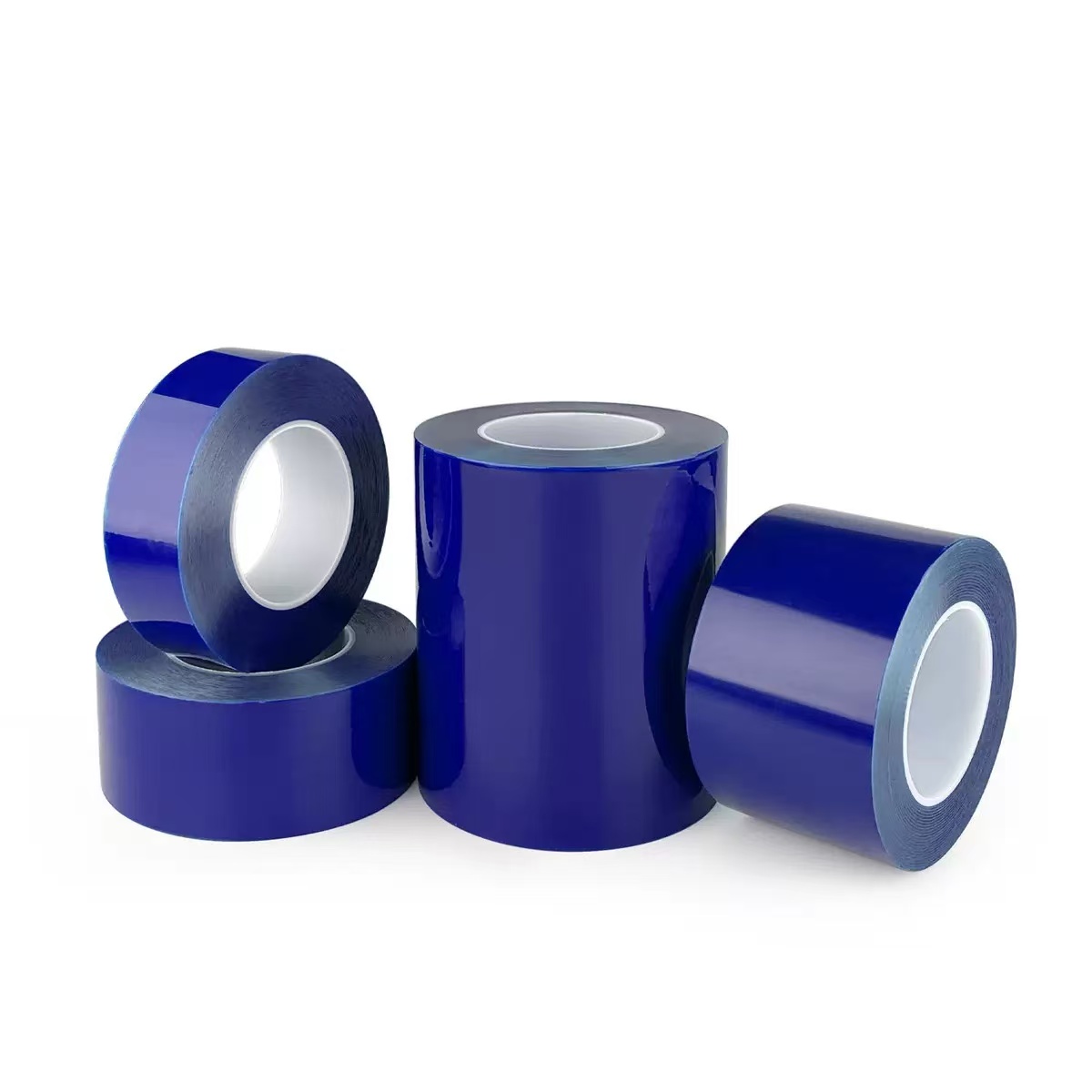
The Versatile World of Transparent PVC Adhesive Protective Film: Properties and Real-World Applications
2025-11-27 11:54 Transparent PVC adhesive film, commonly referred to as PVC protective film, is one of the most widely used temporary surface protection materials in modern manufacturing and finishing industries. This soft, crystal-clear polyvinyl chloride film, coated with a precisely formulated pressure-sensitive adhesive, acts like an invisible second skin that shields delicate surfaces from scratches, dust, fingerprints, abrasion, and minor impacts during processing, transportation, storage, and installation. Once the job is done, it peels off cleanly without leaving residue, restoring the original pristine appearance of the protected item.Core Physical and Chemical PropertiesThe success of transparent PVC adhesive film lies in its balanced combination of properties that can be fine-tuned during manufacturing to meet specific needs.
Transparent PVC adhesive film, commonly referred to as PVC protective film, is one of the most widely used temporary surface protection materials in modern manufacturing and finishing industries. This soft, crystal-clear polyvinyl chloride film, coated with a precisely formulated pressure-sensitive adhesive, acts like an invisible second skin that shields delicate surfaces from scratches, dust, fingerprints, abrasion, and minor impacts during processing, transportation, storage, and installation. Once the job is done, it peels off cleanly without leaving residue, restoring the original pristine appearance of the protected item.Core Physical and Chemical PropertiesThe success of transparent PVC adhesive film lies in its balanced combination of properties that can be fine-tuned during manufacturing to meet specific needs.Excellent Transparency and Gloss
High-quality PVC protective film achieves optical clarity above 90%, sometimes reaching 95–98%. This near-invisible quality allows quality inspectors, installers, and end customers to see the true color, texture, and finish of the substrate at all times. Unlike milky or hazy films, a perfectly transparent PVC film does not hide surface defects, which is critical in industries where aesthetics are paramount.
Controlled Adhesion Levels
Manufacturers offer low-tack (8–15 g/25 mm), medium-tack (20–50 g/25 mm), and high-tack (80–200 g/25 mm) versions measured by 180° peel testing. Low-tack versions are ideal for highly polished mirror-like surfaces, while higher-tack grades securely grip textured or slightly curved parts without creeping or lifting.Conformability and Elasticity
Soft PVC film with 100–200% elongation can stretch and conformily wrap around complex three-dimensional shapes, curved edges, and even sharp corners without wrinkling or tearing. This property makes it indispensable for protecting jewelry, curved automotive trim, and architectural metal profiles.Weather and UV Resistance
Many grades incorporate UV stabilizers that allow outdoor exposure for 6–12 months without yellowing or adhesive degradation. This feature is especially valuable when protected metal sheets or pre-painted panels are stored outdoors before installation.Clean Peel and No Residue
The acrylic or rubber-based adhesive systems are designed to cross-link moderately during aging, ensuring that even after months of application the film peels off in one piece, leaving zero ghosting or sticky marks on stainless steel, aluminum, glossy plastics, or glass.Thickness Range
Common thicknesses range from 0.03 mm (30 micron) ultra-thin films for mirror-polished surfaces to 0.10 mm (100 micron) heavy-duty versions that resist deeper scratches and tool marks during mechanical processing.
 Application 2: Electroplated and PVD-Coated Metal Parts – High-Clarity ProtectionElectroplated chrome door handles, bathroom faucets, automotive bright trim, elevator panels, and architectural hardware represent some of the most scratch-sensitive surfaces in industry. A single fingerprint or scuff during packing can ruin an otherwise perfect mirror chrome finish.Here, medium to high-tack transparent PVC film (50–120 g/25 mm) in 70–100 micron thickness is the standard choice. The film is usually applied automatically by roller laminators immediately after the plating line exits the final rinse and drying tunnel, while parts are still warm and perfectly clean. The slight warmth actually helps the adhesive wet out and conform to microscopic plating peaks, achieving bubble-free contact.Because the adhesive is solvent-free and non-acidic, it never attacks nickel, chromium, or physical vapor deposition (PVD) black chrome, rose gold, or titanium coatings even after six months of storage. Workers in downstream assembly plants can bend, rivet, or ultrasonic-weld parts without first removing the film; the tough PVC layer absorbs tool marks that would otherwise etch the plating. Only at the final installation stage on a construction site or assembly line is the blue or clear film peeled away, revealing a flawless mirror surface beneath.
Application 2: Electroplated and PVD-Coated Metal Parts – High-Clarity ProtectionElectroplated chrome door handles, bathroom faucets, automotive bright trim, elevator panels, and architectural hardware represent some of the most scratch-sensitive surfaces in industry. A single fingerprint or scuff during packing can ruin an otherwise perfect mirror chrome finish.Here, medium to high-tack transparent PVC film (50–120 g/25 mm) in 70–100 micron thickness is the standard choice. The film is usually applied automatically by roller laminators immediately after the plating line exits the final rinse and drying tunnel, while parts are still warm and perfectly clean. The slight warmth actually helps the adhesive wet out and conform to microscopic plating peaks, achieving bubble-free contact.Because the adhesive is solvent-free and non-acidic, it never attacks nickel, chromium, or physical vapor deposition (PVD) black chrome, rose gold, or titanium coatings even after six months of storage. Workers in downstream assembly plants can bend, rivet, or ultrasonic-weld parts without first removing the film; the tough PVC layer absorbs tool marks that would otherwise etch the plating. Only at the final installation stage on a construction site or assembly line is the blue or clear film peeled away, revealing a flawless mirror surface beneath. Application 3: Pre-Painted Metal Coils and SheetsCoil-coated steel and aluminum used for roofing, cladding, white goods, and caravan sidewalls receive their final color and gloss in continuous high-speed painting lines. Immediately after curing ovens, while the paint is still only hours old and therefore relatively soft, a 50–70 micron transparent PVC film is laminated onto the surface at speeds exceeding 100 m/min.This film remains in place while coils are rewound, slit, profiled into roofing sheets, or shipped worldwide. It protects against coil telescoping marks, slitting dust, abrasion during roll-forming, and scratches when workers stack or transport sheets on construction sites. Modern formulations allow the film to survive 12 months of outdoor storage in tropical climates without adhesive transfer or paint lifting.Application 4: Electronics and Appliance Nameplates, Panels, and Touch SurfacesStainless-steel refrigerator doors, glossy black acrylic control panels, and brushed aluminum laptop shells all leave the factory covered edge-to-edge with transparent PVC film. Consumers have become accustomed to peeling off that satisfying layer of “new-product plastic” before first use. For manufacturers, however, this film is serious protection: it prevents the swirl marks caused by automated polishing robots, fingerprints from assembly workers, and scratches when panels are slid into cardboard packing.In the growing market of high-gloss home appliances marketed as “fingerprint-resistant,” the temporary PVC film paradoxically protects the very oleophobic coating that will later resist fingerprints. Without the film, that expensive coating would arrive at retail already marred.
Application 3: Pre-Painted Metal Coils and SheetsCoil-coated steel and aluminum used for roofing, cladding, white goods, and caravan sidewalls receive their final color and gloss in continuous high-speed painting lines. Immediately after curing ovens, while the paint is still only hours old and therefore relatively soft, a 50–70 micron transparent PVC film is laminated onto the surface at speeds exceeding 100 m/min.This film remains in place while coils are rewound, slit, profiled into roofing sheets, or shipped worldwide. It protects against coil telescoping marks, slitting dust, abrasion during roll-forming, and scratches when workers stack or transport sheets on construction sites. Modern formulations allow the film to survive 12 months of outdoor storage in tropical climates without adhesive transfer or paint lifting.Application 4: Electronics and Appliance Nameplates, Panels, and Touch SurfacesStainless-steel refrigerator doors, glossy black acrylic control panels, and brushed aluminum laptop shells all leave the factory covered edge-to-edge with transparent PVC film. Consumers have become accustomed to peeling off that satisfying layer of “new-product plastic” before first use. For manufacturers, however, this film is serious protection: it prevents the swirl marks caused by automated polishing robots, fingerprints from assembly workers, and scratches when panels are slid into cardboard packing.In the growing market of high-gloss home appliances marketed as “fingerprint-resistant,” the temporary PVC film paradoxically protects the very oleophobic coating that will later resist fingerprints. Without the film, that expensive coating would arrive at retail already marred. Application 5: Automotive Interior and Exterior TrimMatte, piano-black, and carbon-look interior trim pieces are among the most complained-about surfaces for visible scratches in new cars. Transparent PVC adhesive film applied at the Tier-1 supplier stays on during vehicle assembly and is only removed by the dealership during pre-delivery inspection. Some premium brands even specify micro-perforated PVC film that allows moisture to escape while still providing scratch protection, preventing any possibility of trapped condensation marks.On the exterior, painted or anodized aluminum roof rails, window trim, and mirror caps receive similar protection to survive automated car-wash brushes at the plant and the occasional parking-lot door ding before customer delivery.
Application 5: Automotive Interior and Exterior TrimMatte, piano-black, and carbon-look interior trim pieces are among the most complained-about surfaces for visible scratches in new cars. Transparent PVC adhesive film applied at the Tier-1 supplier stays on during vehicle assembly and is only removed by the dealership during pre-delivery inspection. Some premium brands even specify micro-perforated PVC film that allows moisture to escape while still providing scratch protection, preventing any possibility of trapped condensation marks.On the exterior, painted or anodized aluminum roof rails, window trim, and mirror caps receive similar protection to survive automated car-wash brushes at the plant and the occasional parking-lot door ding before customer delivery. Environmental and Recycling ConsiderationsModern transparent PVC protective films increasingly use phthalate-free plasticizers and heavy-metal-free stabilizers to meet REACH and RoHS requirements. Many manufacturers now offer versions with solvent-free water-based acrylic adhesives. After peeling, the used film is collected and either mechanically recycled into lower-grade PVC products or incinerated for energy recovery in waste-to-energy plants, since PVC has a high calorific value.Future TrendsThe industry continues to push toward thinner yet tougher films (down to 20–25 micron) that maintain high clarity and clean removal. Anti-microbial additive versions are gaining traction for appliance and elevator panels in hospitals. Printable protective films that carry installation instructions or QR codes directly on the surface are also emerging, eliminating the need for separate paper labels.
Environmental and Recycling ConsiderationsModern transparent PVC protective films increasingly use phthalate-free plasticizers and heavy-metal-free stabilizers to meet REACH and RoHS requirements. Many manufacturers now offer versions with solvent-free water-based acrylic adhesives. After peeling, the used film is collected and either mechanically recycled into lower-grade PVC products or incinerated for energy recovery in waste-to-energy plants, since PVC has a high calorific value.Future TrendsThe industry continues to push toward thinner yet tougher films (down to 20–25 micron) that maintain high clarity and clean removal. Anti-microbial additive versions are gaining traction for appliance and elevator panels in hospitals. Printable protective films that carry installation instructions or QR codes directly on the surface are also emerging, eliminating the need for separate paper labels. ConclusionTransparent PVC adhesive protective film may be one of the humblest materials in modern manufacturing, but its impact is enormous. By forming a temporary, invisible shield that disappears without a trace the moment it is no longer needed, it preserves the beauty and value of everything from a platinum wedding ring to a skyscraper’s mirrored façade. Its combination of optical clarity, controlled adhesion, conformability, and clean peel performance makes it an indispensable partner across jewelry, electroplating, coil coating, electronics, appliances, and automotive sectors—an unsung hero that lets perfection reach the customer exactly as the designer intended.
ConclusionTransparent PVC adhesive protective film may be one of the humblest materials in modern manufacturing, but its impact is enormous. By forming a temporary, invisible shield that disappears without a trace the moment it is no longer needed, it preserves the beauty and value of everything from a platinum wedding ring to a skyscraper’s mirrored façade. Its combination of optical clarity, controlled adhesion, conformability, and clean peel performance makes it an indispensable partner across jewelry, electroplating, coil coating, electronics, appliances, and automotive sectors—an unsung hero that lets perfection reach the customer exactly as the designer intended.
